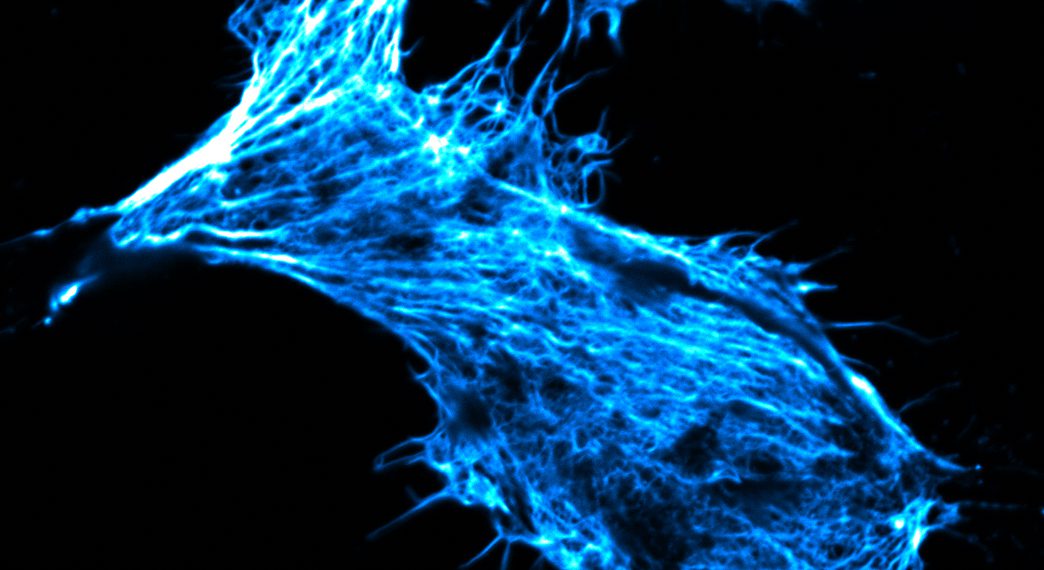Scientists have now developed nanocontainers from sugar and protein components. These use natural processes to transport substances into cells for which the cell membrane is otherwise impermeable — for example, labeled substances to study cell functions or drugs. The study appeared in Advanced Science.
Nanocontainers can be used to transport substances specifically into the interior of cells, where they can then exert their effect. This method is used, for example, in the currently used mRNA vaccines against covid-19 and certain cancer drugs. In research, such drug transporters can also be used to introduce labeled substances into cells and thus investigate basic cellular functions. In order to exploit their potential, intensive research is being conducted into how nanocontainers interact with biological environments and how they can be chemically structured to deliver substances into cells as gently and in a controlled manner as possible.
Scientists at the Westfälische Wilhelms-Universität Münster (WWU) have now developed a new type of nanocontainer that is constructed entirely from biological components. Unlike other drug transporters, they are not based on lipids, i.e. fats, but on sugar compounds and are sealed by a layer of protein structures — so-called polypeptides — that is precisely matched in thickness.
“Although we manufacture the components of our nanocontainers synthetically, they are taken up by cells just like naturally occurring substances and — due to the overall structure we have developed — are also degraded.”
- Chemist Prof. Dr. Bart Jan Ravoo
“For the degradation of the container shell inside the cell, we exploit two natural mechanisms at once — as a result, the transported substances are released rapidly as soon as they arrive in the cell,” adds biochemist Prof. Dr. Volker Gerke.
The scientists want to use the tiny nanocontainers with a diameter of about 150 nanometers to introduce labeled biologically relevant lipids into cells and thus study transport processes in the cell membrane. In addition, they would like to further develop the chemical design of the containers so that, for example, they are only taken up by certain types of cells or to be able to control the release of the cargo from the outside by light. In the future, transport systems built from sugar and protein components could also be suitable for applications in living organisms to deliver drugs specifically to the places where they are needed. The study appeared in the journal Advanced Science.
Bioinspired materials organize into loaded containers
To create the new drug transporters, the scientists used sugar compounds (modified cyclodextrins) that resemble lipids in structure — and thus behavior — that occur naturally in every cell. Like the protective cell membrane lipids, the sugar structures arrange themselves to form a shell in which they enclose the substances to be transported. However, because the resulting container is still leaky and would lose its charge over time, the scientists added protein structures (polypeptides) that form a protective layer around the container. “To test how thick the protective layer needed to be, we varied the length of the peptide sequences and tailored them so that the containers stably encapsulated their cargo,” explains Sharafudheen Pottanam Chali, a chemistry PhD student and one of the study’s two first authors.
Nanocontainers use a natural pathway into cells
In the next step, the scientists investigated whether and how the newly developed nanocontainers were taken up by cells. Their hypothesis was that this happens via so-called endocytosis. In this process, the cells turn part of their cell membrane inside out and lace it off, creating small vesicles — the endosomes — in which the extracellular material is transported into the cell. To test this, the scientists used a sugar compound (dextran) known to be taken up by endosomes.
They added red fluorescent dextran as well as nanocontainers filled with a green fluorescent cargo (pyranin) to a cell culture. “On the fluorescence microscope, it became visible that both substances were taken up into the cells in the same way and that their fluorescence overlapped there — from this we could conclude that the nanocontainers, just like the dextran, were efficiently taken up by the cells through the endosomal transport process,” explains Sergej Kudruk, a biochemistry doctoral student and also first author of the study. The scientists checked this for two different cell types — human blood vessel cells and cancer cells.
Container envelope is degraded by enzymes in the cells’ endosomes
Inside the endosomes, there are conditions that are different from the cell environment. The scientists already had this in mind when designing their nanocontainers and built them in such a way that the altered environment in the endosomes destabilizes and partially degrades the polypeptide shell — the nanocontainers thus become leaky and release their cargo into the interior of the cell. “Two types of enzymes, which we knew to be present in endosomes and which can participate in the degradation of the shell at specific sites, act in the degradation of the container shell,” explains Sergej Kudruk.
“So-called reductases degrade the disulfide bridges that were previously established and cross-link the peptide molecules of our nanocontainer — in addition, peptidases cleave the peptide molecules themselves,” adds Sharafudheen Pottanam Chali. The scientists also tested the degradability of the container shell outside the cell. To do this, they loaded the containers with a fluorescent dye and simulated part of the complex endosomal microenvironment by using the enzyme trypsin and reducing agents. After treatment, the dye leaked out unmistakably.

















